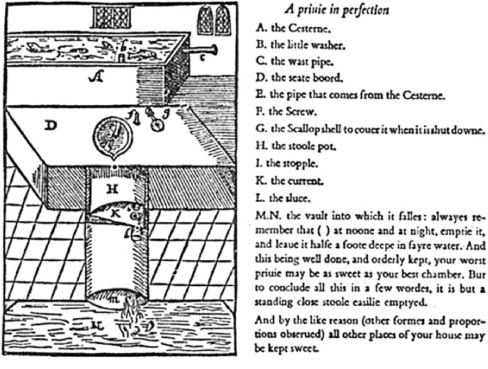The Stone Detective: The Crapper Case – It’s Not What You Think
Frederick M. Hueston, PhD
I was sitting at my local greasy spoon enjoying my third cup of joe – and of course, flirting with Flo – when I had this sudden urge – uh, call of nature. So, I told Flo, “Thanks for all the coffee, now I have to visit the little detective’s room.”
Now, I won’t bore you or gore you with the details, but while I was in there, my phone rang. NO, you didn’t – I’m sure you’re thinking. Did the stone detective actually answer his phone while sitting on the throne? NO, I did not. I let it go to voicemail, but when I checked it when I was done, it had something to do with the crapper. The voicemail said they had a marble floor in a bathroom that was developing a mysterious stain around the base of the toilet. So my first thought was that someone had a bad aim or they were cleaning it with the wrong chemical, but this stain seemed unusual. The caller went on to say that the stain would appear as a gummy substance. They would scrape it up and it would return the next day. I had an idea of what it could be, but I told them I would have to come out to perform an inspection. So, I set up a time and a date.
The day had arrived for the “Crapper Case.” I hopped into the old Woody and I was off. On the ride over, I couldn’t help but think about all the unusual facts about the loo. Here are some of those facts:
- The reason we sometimes call the bathroom the crapper? In England the first flush toilets were made by Crapper & Co Ltd. That was stamped on all the toilets, and soldiers would just call it the Crapper. So, the title was coined in England, but made it across the pond to the US.
- How many of you call the toilet the John? Back in the 1500s, John Harrington was credited for ‘inventing’ the modern potty, and hence many people still call it the John. Plus, it’s a lot easier to say than guarderobe.
- The oldest toilet is still functioning about 4,000 years after it was built. It can be seen in Knossos in Greece, in a small castle.
- The original use of ‘toilet,’ derived from the French,’ means – “act of washing, dressing, and preparing oneself.”
…And there are many more facts, but I don’t want to flush your memory with all the facts… or pun-ish you any more.
I arrived at my client’s home. He immediately took me to the bathroom and pointed down at this yellowish, gummy substance that was puddled completely around the perimeter of the toilet base. I took out my knife and scraped some up. I was about to run my finger to feel how gooey the substance was but stopped in mid-reach – thought for a moment – and grabbed a pair of surgical gloves from my inspection bag. I rubbed the substance between my fingers and asked the following question. Did you recently have a new toilet installed? He told me yes, and I knew right away what it was.
 |
|
Sir John Harrington’s flush toilet design, described in his 1596 book The Metamorphasis of Ajax. |
I’m sure you amateur plumbers and DDIY guys out there know, but for you plumbing-challenged people: when toilets are installed, they place what is called a wax ring to seal the toilet to the floor and plumbing. This wax ring is compressed when the bolts on the toilet are tightened. SO, this goo was nothing more than the wax ring oozing out. It would eventually go away. I told him that all he needed to do was scrape it up and clean it, and it would stop at some point. So, the Crapper Case is solved and now I can go. I mean leave.
Well, you know what I mean.
Now, did you know…
- 2.6 billion people do not have access to even a basic toilet.
- Only 7% of Afghanistan homes have flush toilets.
- The average life expectancy of a toilet is 50 years.
- The toilet on the international space station cost 19 million dollars.
- In China, there are public toilets for dogs.
- The more features your smart phone has, the longer you spend in the bathroom.
Until next month: Be kind, keep the lid down, and don’t forget to flush.
The Stone Detective is a fictional character created by Dr. Frederick M. Hueston, PhD, written to entertain and educate. Dr. Fred has written over 33 books on stone and tile installations, fabrication and restoration and also serves as an expert for many legal cases across the world. Fred has also been writing for the Slippery Rock for over 20 years.
Send your comments to fhueston@stoneforensics.com.